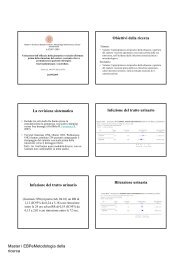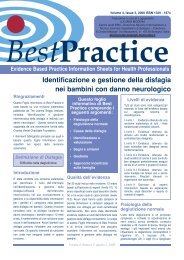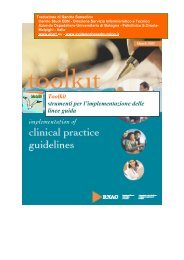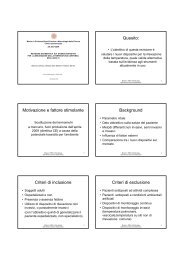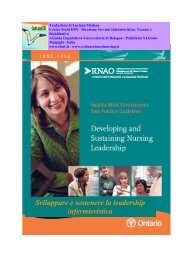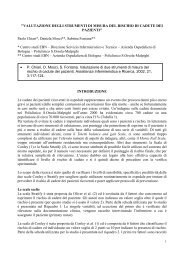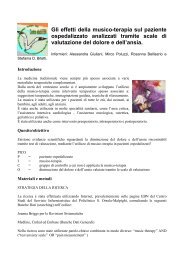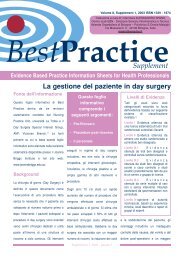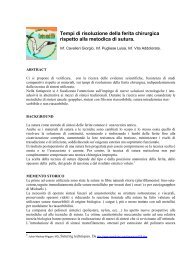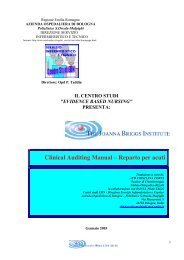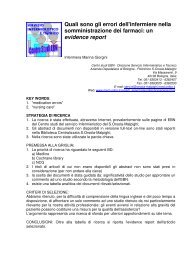Ulcere da pressione - Evidence Based Nursing
Ulcere da pressione - Evidence Based Nursing
Ulcere da pressione - Evidence Based Nursing
- No tags were found...
Create successful ePaper yourself
Turn your PDF publications into a flip-book with our unique Google optimized e-Paper software.
monitorati per stabilire i livelli diperformance. (AHCPR 1994)Raccoman<strong>da</strong>zioni perConseguire unmiglioramento Continuodella Qualità:Leggere la Parte I del foglio informativoriguar<strong>da</strong>nte la prevenzione. I programmieducazionali sul trattamento delle lesioni <strong>da</strong><strong>pressione</strong> devono essere diretti verso tutti ilivelli clinici, i pazienti gli altri individui che siprendono cura dei pazienti.Questi programmi devono contenere:• Eziologia, patogenesi & fattori di rischio.• Uniforme stadiazione del <strong>da</strong>nnotessutale.• Concetti di guarigione delle ferite.• Concetti di supporto nutrizionale.• Programmi individualizzati di cura dellacute.• Concetti di detersione e di controllodell’infezione.• Concetti di assistenza post-operatoria.• Concetti di prevenzione.• Selezione dei prodotti (per es. tipi eutilizzi dei supporti di superficie, dellemedicazioni, dei farmaci topici o di altriagenti).• Effetti o influenza dei fattori fisici emeccanici sulle lesioni <strong>da</strong> <strong>pressione</strong> e lestrategie di gestione.• Mo<strong>da</strong>lità accurate di documentazione emonitoraggio ei <strong>da</strong>ti pertinenti compresigli interventi e i progressi nellaguarigione. (AHCPR 1994) ER=Op• Revisione del programma.Aggiornamento del programmaeducazionale in itinere e su base regolareper integrare le nuove conoscenze,tecniche o tecnologie. (AHCPR 1994)Gli effetti di programmi, la variabilità nellapratica e gli outcome clinici devonoessere sottoposti a costantemonitoraggio.This publication is the result of a collaborative project involving: Royal Adelaide Hospital, MaterMisericordiae Public Hospitals South Brisbane, Concord Repatriation General Hospital Concord,Royal Hobart Hospital and North West Hospital Carlton South. The project has been led by:Professor Alan Pearson, Director, The Joanna Briggs Institute for <strong>Evidence</strong> <strong>Based</strong> <strong>Nursing</strong>, RoyalAdelaide Hospital.Mr Rick Wiechula, Coodinator - Evaluation, The Joanna Briggs Institute for <strong>Evidence</strong> <strong>Based</strong><strong>Nursing</strong>, Royal Adelaide Hospital.Dr. Grace Croft, Assistant Director of <strong>Nursing</strong> - Research, mater Misericordiae Public HospitalsSouth Brisbane.Professor Judy Lumby E.M. Lane Chair in Surgical <strong>Nursing</strong>, Concord Repatriation General HospitalConcord. Ms Pat Hickson, Senior Lecturer School of <strong>Nursing</strong>, University of Tasmania Hobart.Professor Rhon<strong>da</strong> Nay, Professor of Gerontic <strong>Nursing</strong>, NorthWest Hospital Carlton South.Margaret Graham Building,Royal Adelaide Hospital, North Terrace,Adelaide, South Australia 5000http://www.joannabriggs.edu.auph: (+61 8) 8303 4880 fax: (+61 8) 8303 4881NHS Centre for Reviews and Dissemination, SubscriptionsDepartment, Pearson Professiona, PO Box 77, FourthAvenue, Harlow CM19 5BQ.AHCPR Publications Clearing House, PO Box 8547, SilverSpring,MD 20907The series Best Practice is disseminatedcollaboratively by:THE JOANNA BRIGGS INSTITUTEThe information containedwithin Best Practice isbased on the best availableevidence as determined bythe systematic review ofresearch. Great care istaken to ensure that thecontent accurately reflectsthe findings of the reviews,however The JoannaBriggs institute for<strong>Evidence</strong> <strong>Based</strong> <strong>Nursing</strong>and organisations fromwhich information may bederived, cannot be heldliable for <strong>da</strong>mages arisingfrom the use of BestPractice.Questo foglio informativo é stato fatto <strong>da</strong>Rick Wiechula e si basa principalmentesulle seguenti pubblicazione del JoannaBriggs Institute for <strong>Evidence</strong> <strong>Based</strong>nursing1. Panel for the Prediction andPrevention of Pressure Ulcers inAdults. Pressure Ulcers in Adults:Predictions and Prevention. ClinicalPractice Guideline, Number 3. AHCPRPublication No. 92-Rockville, MD:Agency for Health Care Policy andResearch, Public Health Service, U.S.Department of Health and HumanServices, May 1992.2. Bergstrom N, Bennett MA, CarlsonCE, et al. Treatment of PressureUlcers. Clinical Practice Guideline,Number 15. Rocjville, MD: U.S.Department of Health and HumanServices. Public Health Service,Agency for Health Care Policy andResearch, AHCPR Publication No. 95-0652 December 1994.3. NHS Centre for Reviews andDissemination. The prevention andtreatment of pressure sores (effectivehealth care bulletin) York: UniversityOf York; 1995.Altri riferimenti sono;Reid, J., Morison, M. (1994). Towards aconcensus: Classification of PressureSores. Journal of Wound Care 3(3), 157-160.Volume 1, Numero 2, pagina 6, 1997



